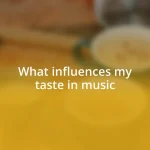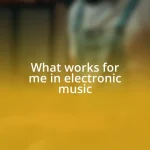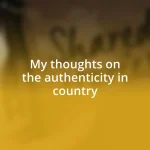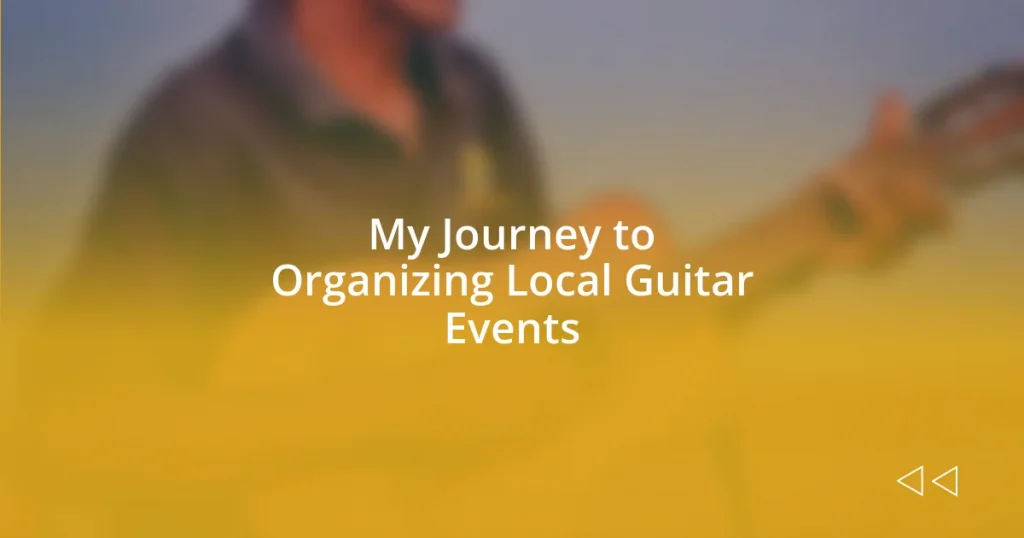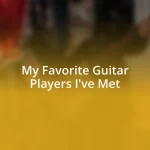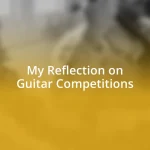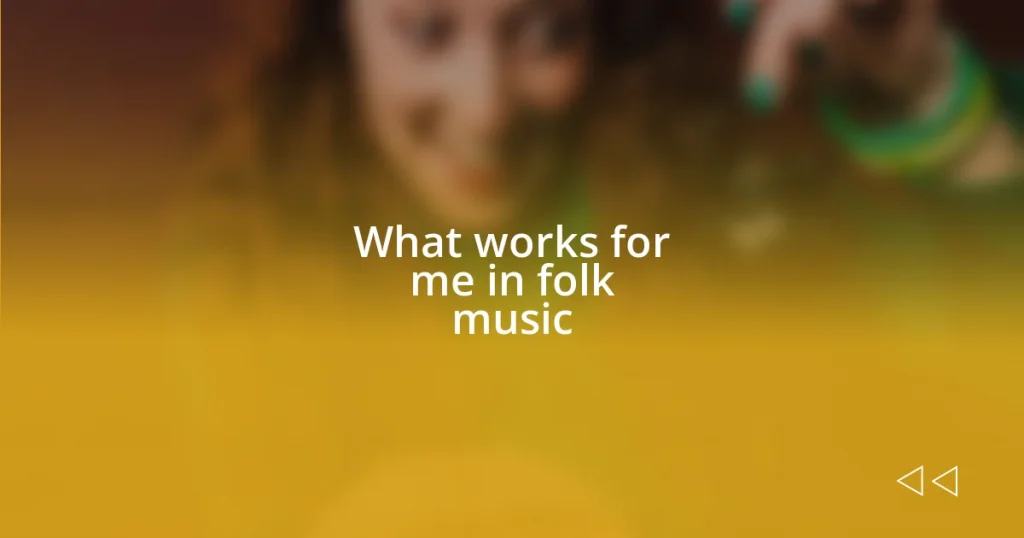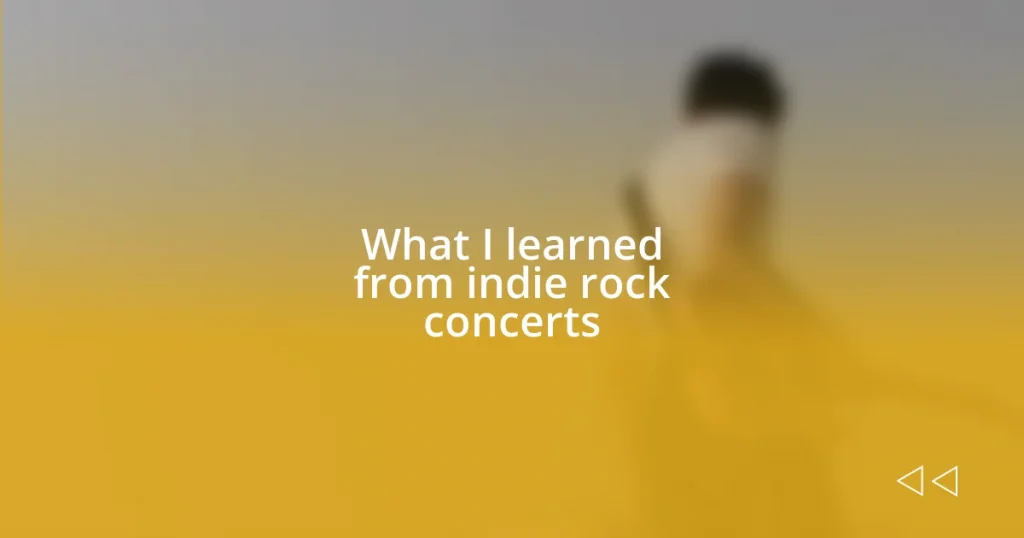Key takeaways:
- Engage local guitar enthusiasts through music shops, social media groups, and informal gatherings to build a community.
- Choose the right venue by prioritizing atmosphere, accessibility, and acoustics to enhance the event experience.
- Gather post-event feedback through conversations, surveys, and social media to continually improve future events.
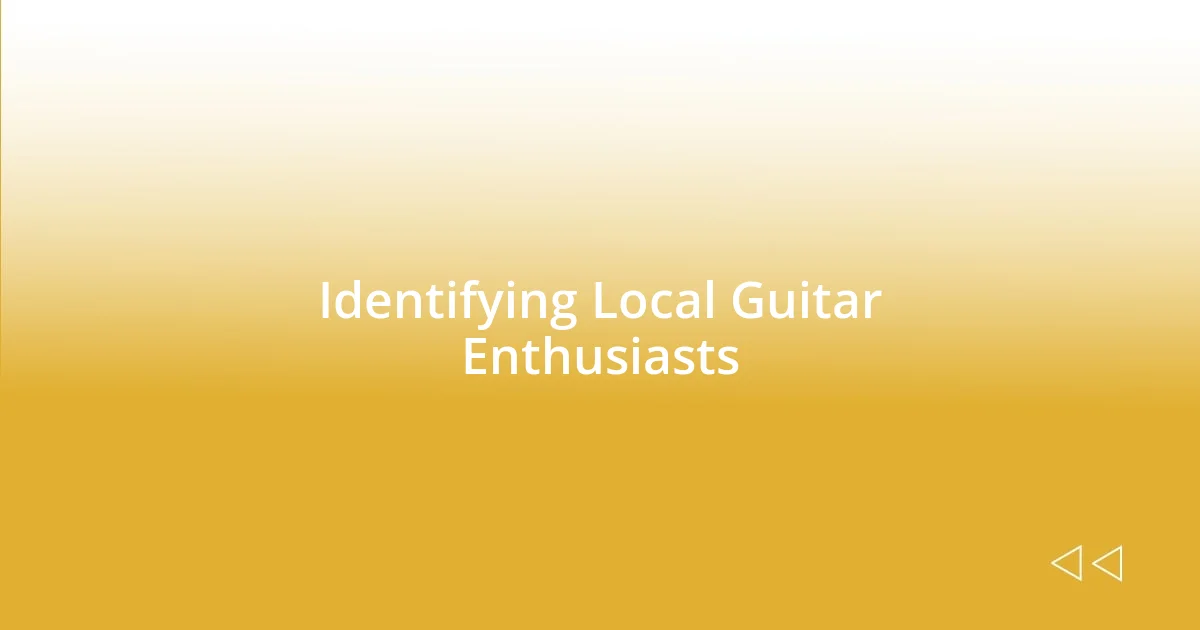
Identifying Local Guitar Enthusiasts
Finding local guitar enthusiasts can be like unearthing hidden gems in your community. I remember one Saturday morning, I strolled through the local coffee shop, and there they were—two musicians passionately jamming with their guitars. It struck me that sometimes, these gatherings happen in the most unexpected places. Have you ever considered where enthusiasts might congregate?
Engaging with local music shops was a game-changer for me. The owners often know the regulars and can connect you with individuals who share your passion. Just last month, I chatted with a shopkeeper who introduced me to a group of players who meet weekly in a nearby park. Have you tapped into your local music shop’s network?
Social media platforms can also play a significant role. I once stumbled upon a Facebook group dedicated to guitarists in my area, where players share tips and organize meet-ups. It was amazing to witness how many like-minded individuals were eager to collaborate and learn together. Have you explored whether such communities exist in your area?
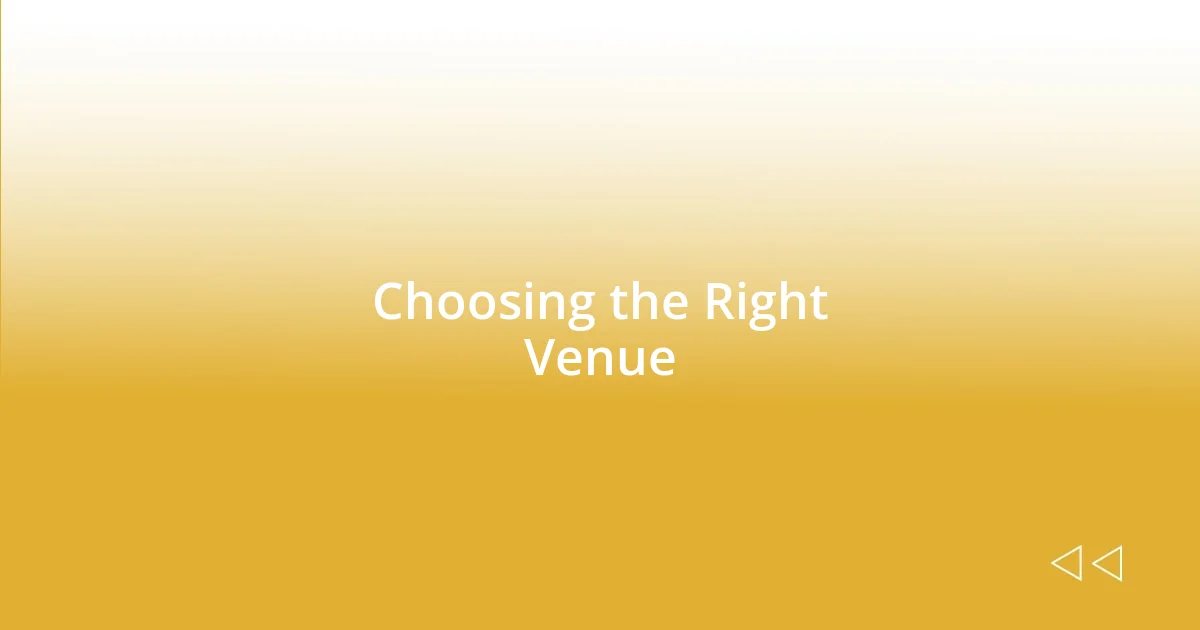
Choosing the Right Venue
Choosing the right venue is crucial for creating a successful local guitar event. From my experience, the atmosphere can make or break the vibe of the entire gathering. I once hosted a small jam session in a cozy backyard, and the intimate setting fostered connections that lingered long after the last chord was played. Have you thought about how the surroundings could enhance the experience?
Accessibility is another factor that I’ve learned to prioritize. When I organized an event at a local community center, I noticed a significant increase in attendance, partly because it was easy for everyone to reach. It’s essential to consider parking availability, public transport options, and even the venue’s capacity to accommodate both players and spectators. Have you evaluated the logistics of your potential venues?
Lastly, the acoustics of a venue can transform a good event into a great one. I remember my first experience in a hall that was poorly designed for music; the sound was muddled, and it left the performers and audience frustrated. Choosing a venue with good acoustics not only enhances the musicians’ performance but also elevates the listener’s enjoyment. What qualities do you think make a venue acoustically pleasing?
| Criteria | Considerations |
|---|---|
| Atmosphere | Intimacy and vibe can enhance connections |
| Accessibility | Parking, transport, and capacity are key |
| Acoustics | Good sound quality enhances enjoyment |
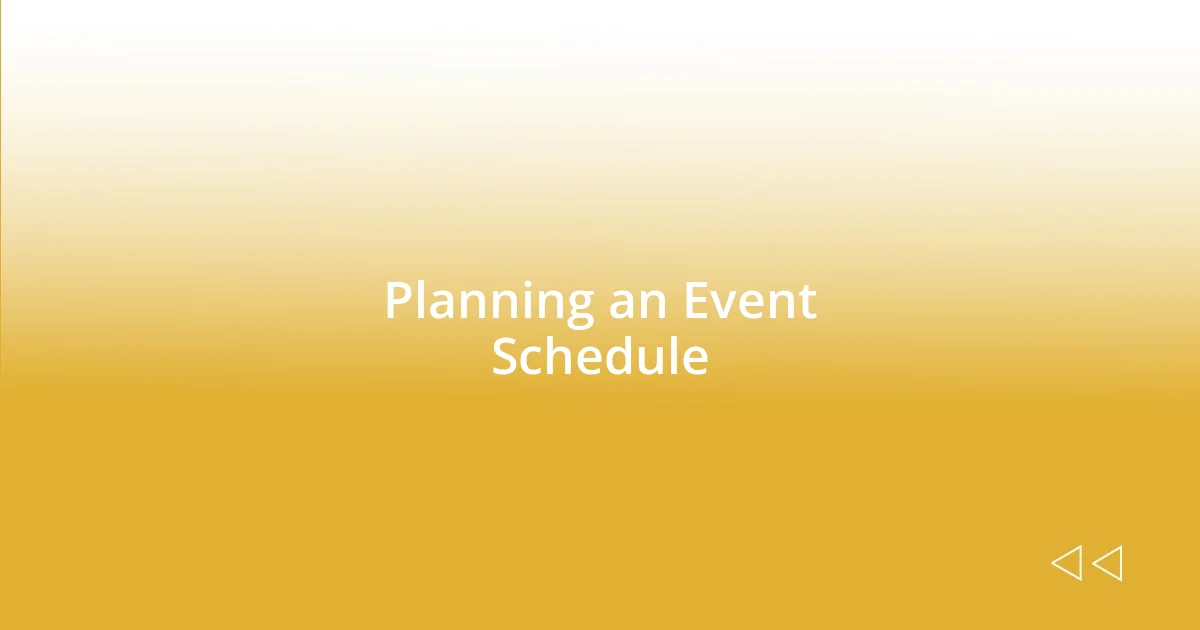
Planning an Event Schedule
Planning an event schedule requires a blend of creativity and practicality. I remember my first event when I thought I could just throw some dates together and call it done. But I quickly learned that a well-thought-out schedule can make all the difference in attendance and engagement. For example, spacing out performances and activities gives everyone time to mingle and share their passion for music.
When planning your schedule, consider these factors:
- Time Slots: Allocate time for soundchecks and breaks to avoid rushing the musicians.
- Performance Order: Positioning rising stars in between more established acts can create a dynamic flow.
- Interactive Sessions: Incorporate workshops or jam sessions to encourage participation and networking among attendees.
- Promotional Lead Times: Give yourself enough time to promote the event, transforming interest into attendance.
On the other hand, avoid cramming too much into one day; it can overwhelm both the players and the audience. My first guess was that more acts meant more excitement, but I soon realized that people valued quality over quantity. A balanced schedule allows everyone to savor the music and connect in a more meaningful way.
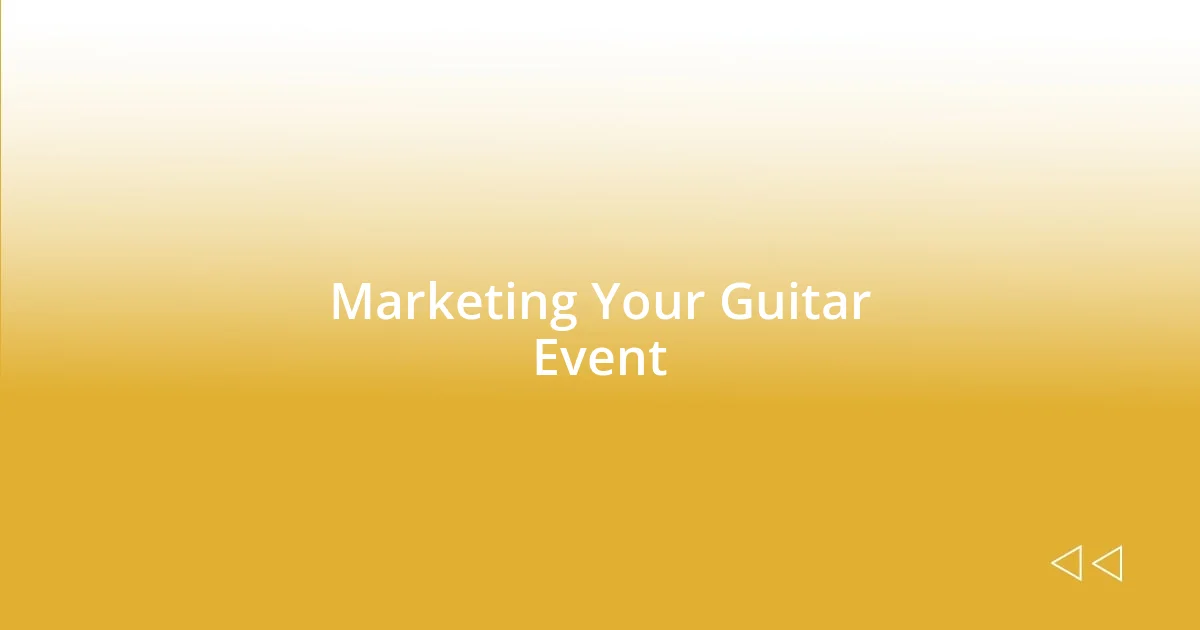
Marketing Your Guitar Event
Marketing your guitar event is a blend of creativity and strategic planning. I vividly remember my initial efforts to promote a small gathering; I thought simply posting on social media would suffice. What I found out through trial and error is that targeted marketing, including local flyers and community boards, really helped get the word out. By engaging the local music community, I transformed that first event into a vibrant celebration of talent and passion.
Don’t underestimate the power of partnerships in marketing your event. A memorable moment for me was when I collaborated with a local music store that offered promotional support. They shared the event details with their customer base, drawing in music enthusiasts who were eager to discover local talent. Have you considered local businesses or influencers to amplify your reach? Building these relationships can not only bolster your marketing efforts but also create a sense of community around your event.
When it comes to online marketing, be sure to leverage video content. My favorite engagement tool has become live sessions or sneak peeks of rehearsals shared on social media platforms. The authenticity of seeing musicians preparing for an event can stir excitement and anticipation. What do you think resonates most with potential attendees? I’ve found that connecting on a personal level through genuine content makes a massive impact, drawing people into the experience even before the event begins.
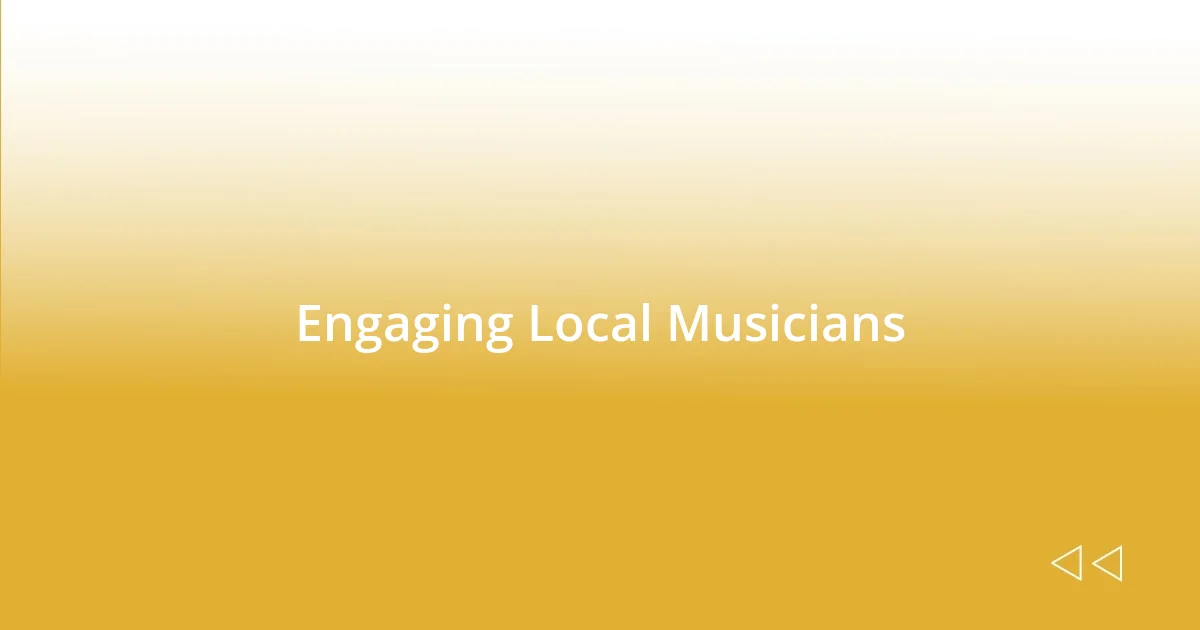
Engaging Local Musicians
Engaging local musicians is crucial for creating a vibrant event. I recall a moment when I reached out to a guitarist who was hesitant to join because she felt overshadowed by more established acts. Through a genuine conversation, I encouraged her by highlighting how her unique style would resonate with the crowd. It struck me that often, all it takes is a little encouragement to bring hidden talent into the spotlight.
In my experience, hosting informal jam sessions before the main event is a fantastic way to engage musicians. I set up a casual meet-up at my local coffee shop once, and it was exhilarating to see musicians bonding over shared riffs and ideas. This laid-back environment allowed them to connect with one another, paving the way for collaborations that sparked creativity. Have you thought about how an informal setting can enhance participation?
I also learned that reaching out via personal messages can make a big difference. When I first started inviting musicians, I sent direct messages on social media instead of generic invites. I remember one guitarist responded, saying that my personalized approach made him feel valued. This sparked a sense of community and camaraderie that is essential for any event. What techniques do you think would resonate with your local artists? I’ve found that a personal touch fosters deeper connections and makes everyone feel part of something special.
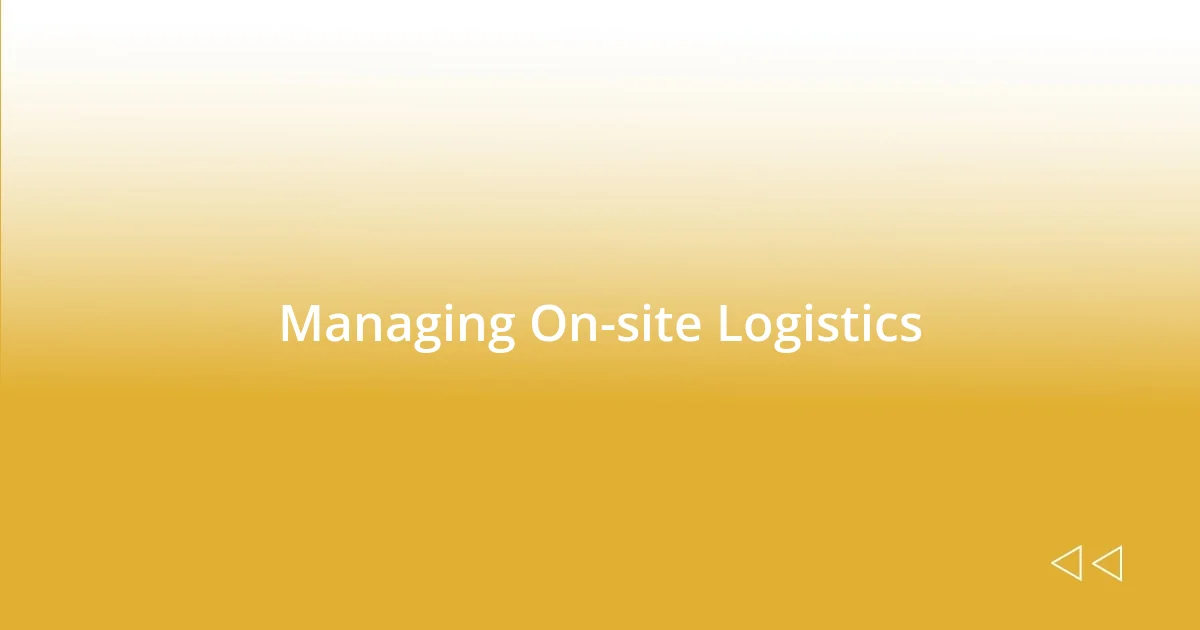
Managing On-site Logistics
Managing on-site logistics is where every detail counts. I recall the first time I coordinated an event, and chaos nearly ensued because I hadn’t mapped out a clear layout for the venue. I learned quickly that having designated areas for musicians, equipment, and audience interaction not only streamlined the flow but also created a more enjoyable experience for everyone involved. Have you ever stepped into a poorly organized event? The sense of disarray can be off-putting, so I strive to avoid that at all costs.
Transportation is another logistical puzzle to consider. I remember booking a local band whose instruments needed transporting, and it became vital to arrange a reliable way to get them to the venue. I coordinated with a team of volunteers, and it turned out to be a fantastic bonding experience—it established a strong sense of teamwork that resonated throughout the event. How have you thought about managing equipment transport and ensuring everything arrives on time? It’s a critical step that can significantly impact the event’s success.
Then there’s the moment of truth—setting up on the day of the event. I can’t forget the adrenaline rush when I checked the sound system and noticed issues just hours before showtime. I quickly adapted, bringing in a local tech guru I trusted for last-minute fixes. That taught me the importance of having backup plans and trusted contacts readily available. Isn’t it reassuring to know you have a solution at hand when things go awry? These experiences have shaped my approach to logistics, turning potential chaos into harmonious events.
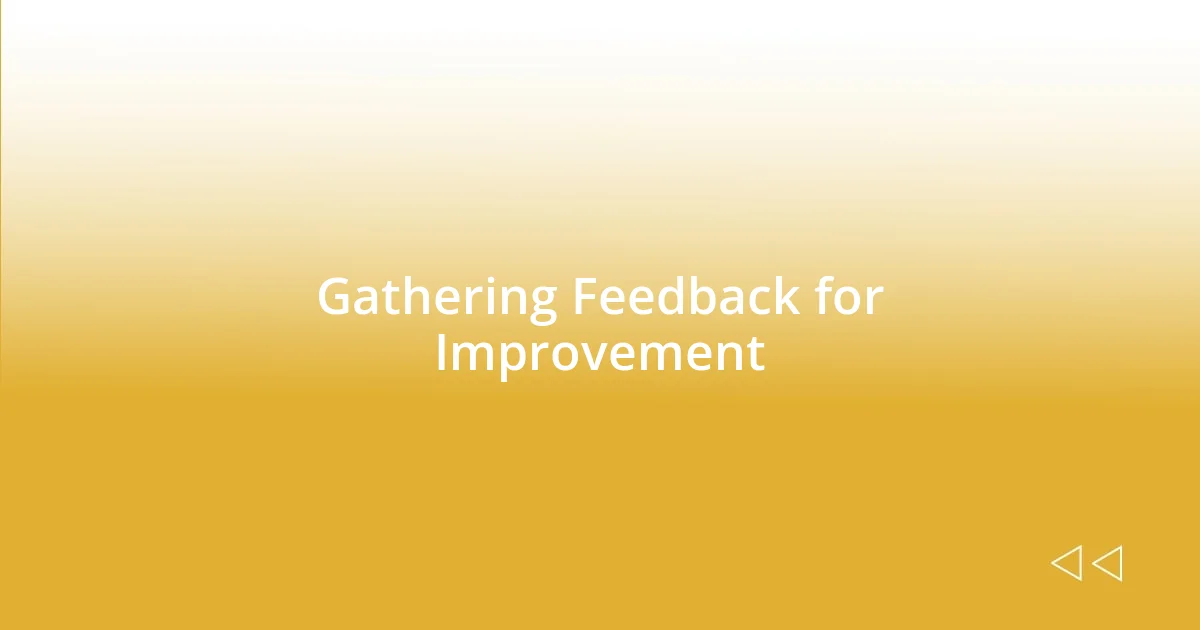
Gathering Feedback for Improvement
Gathering feedback is an integral part of improving any local guitar event. After each event, I make it a point to connect with both the musicians and attendees to hear their thoughts. I remember a particularly enlightening conversation with an audience member who suggested incorporating more diverse genres. This simple feedback led me to rethink the lineup for future events, and it invigorated the atmosphere in ways I couldn’t have imagined. Isn’t it fascinating how one person’s perspective can shift the whole vibe?
Another method I’ve employed is utilizing online surveys. I crafted a quick survey after my last event, focusing on aspects like performance quality and venue comfort. To my surprise, the direct responses returned were incredibly constructive. One participant voiced that the seating arrangements could be improved, which I hadn’t considered at all. This sort of insight is gold because it helps create a more welcoming environment for everyone involved. Have you thought about how structured feedback can lead to significant enhancements?
I also take time to analyze social media interactions post-event. For instance, after sharing highlights, I noticed a pattern in the comments where many attendees expressed a desire for more interactive segments, like Q&As or workshops. This sparked a creative idea to add an open mic segment in my next gathering. Doesn’t it make sense to leverage the natural conversations that happen online? This way, the engagement continues beyond the event itself, fostering a shared sense of community and continuous improvement.


